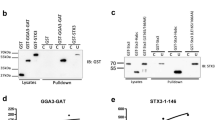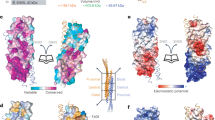Abstract
Surface expression of the nicotinic acetylcholine receptor (AChR) requires the assembly of multiple subunits in the endoplasmic reticulum (ER). Little is known, however, about the mechanism by which assembled receptor pentamers are transported to the cell membrane while unassembled subunits are retained in the ER. Here we report that a motif conserved in the transmembrane domain of AChR subunits is critically involved in this process. In COS cells, mutation within this signal allowed surface expression of unassembled subunits. Conversely, insertion of the sequence to unrelated proteins that are normally transported to the surface resulted in ER retention. The signal is buried in AChR pentamers, but is exposed on unassembled subunits in the ER, where it promotes protein degradation. We therefore conclude that this signal ensures surface trafficking of only functional AChRs.
This is a preview of subscription content, access via your institution
Access options
Subscribe to this journal
Receive 12 print issues and online access
$209.00 per year
only $17.42 per issue
Buy this article
- Purchase on Springer Link
- Instant access to full article PDF
Prices may be subject to local taxes which are calculated during checkout







Similar content being viewed by others
References
Karlin, A. Emerging structure of the nicotinic acetylcholine receptors. Nat. Rev. Neurosci. 3, 102–114 (2002).
Smith, M.M., Lindstrom, J. & Merlie, J.P. Formation of the α-bungarotoxin binding site and assembly of the acetylcholine receptor subunits occur in the endoplasmic reticulum. J. Biol. Chem. 262, 4367–4376 (1987).
Verrall, S. & Hall, Z.W. The N-terminal domains of acetylcholine receptor subunits contain recognition signals for the initial steps of receptor assembly. Cell 68, 23–31 (1992).
Blount, P., McHardy, M.S. & Merlie, J.P. Assembly intermediates of the mouse muscle nicotinic acetylcholine receptor in stably transfected fibroblasts. J. Cell Biol. 111, 2601–2611 (1990).
Gu, Y., Forsayeth, J.R., Verrall, S., Yu, X.-M. & Hall, Z.W. Assembly of the mammalian acetylcholine receptor in transfected COS cells. J. Cell Biol. 114, 799–807 (1991).
Saedi, M.S., Conroy, W.G. & Lindstrom, J. Assembly of Torpedo acetylcholine receptors in Xenopus oocytes. J. Cell Biol. 112, 1007–1015 (1991).
Merlie, J.P. & Lindstrom, J. Assembly in vivo of mouse muscle acetylcholine receptor: identification of an α subunit species that may be an assembly intermediate. Cell 34, 747–757 (1983).
Blount, P. & Merlie, J.P. Mutational analysis of muscle nicotinic acetylcholine receptor subunit assembly. J. Cell Biol. 111, 2613–2622 (1990).
Green, W.N. & Claudio, T. Acetylcholine receptor assembly: subunit folding and oligomerization occur sequentially. Cell 74, 57–69 (1993).
Kreienkamp, H.J., Maeda, R.K., Sine, S.M. & Taylor, P. Intersubunit contacts governing assembly of the mammalian nicotinic acetylcholine receptor. Neuron 14, 635–644 (1995).
Nicke, A., Rettinger, J., Mutschler, E. & Schmalzing, G. Blue native PAGE as a useful method for the analysis of the assembly of distinct combinations of nicotinic acetylcholine receptor subunits. J. Recept. Signal Transduct. Res. 19, 493–507 (1999).
Black, R., Goldman, D., Hochschwender, S., Lindstrom, J. & Hall, Z.W. Genetic variants of C2 muscle cells that are defective in synthesis of the α-subunit of the acetylcholine receptor. J. Cell Biol. 105, 1329–1336 (1987).
Gu, Y., Ralston, E., Murhy-Erdosh, C., Black, R. & Hall, Z.W. Acetylcholine receptor in a C2 muscle cell variant is retained in the endoplasmic reticulum. J. Cell Biol. 109, 729–738 (1989).
Lindstrom, J. in Ion Channels Vol. 4 (ed. Narahashi, T.) 377–450 (Plenum, New York, 1996).
Barnes, E.M. Intracellular trafficking of GABAA receptors. Life Sci. 66, 1063–1070 (2000).
Griffon, N. et al. Molecular determinants of glycine receptor subunit assembly. EMBO J. 18, 4711–4721 (1999).
Kuhse, J., Betz, H. & Kirsch, J. The inhibitory glycine receptor: architecture, synaptic localization and molecular pathology of a postsynaptic ion-channel complex. Curr. Opin. Neurobiol. 5, 318–323 (1995).
Gu, Y., Franco, A., Gardner, P.D., Lansman, J.B. & Hall, Z.W. Properties of embryonic and adult muscle acetylcholine receptors transiently expressed in COS cells. Neuron 5, 147–157 (1990).
Guillick, W. & Lindstrom, J. Mapping the binding of monoclonal antibodies to the acetylcholine receptor form Torpedo californica. Biochemistry 22, 3312–3320 (1983).
Ratnam, M. et al. Location of antigenic determinants on primary sequences of subunits of nicotinic acetylcholine receptor by peptide mapping. Biochemistry 25, 2621–2632 (1986).
Froehner, S.C., Douville, K., Klink, S. & Culp, W.J. Monoclonal antibodies to cytoplasmic domains of the acetylcholine receptor. J. Biol. Chem. 258, 7112–7120 (1983).
Kurosaki, T. et al. Functional properties of nicotinic acetylcholine receptor subunits expressed in various combinations. FEBS Lett. 214, 253–258 (1987).
Sine, S.M. & Claudio, T. Stable expression of the mouse nicotinic acetylcholine receptor in mouse fibroblasts. Comparison of receptors in native and transfected cells. J. Biol. Chem. 266, 13679–13689 (1991).
Wang, Z.-Z., Hardy, S.F. & Hall, Z.W. Assembly of the nicotinic acetylcholine receptor. The first transmembrane domains of truncated α and δ subunits are required for heterodimer formation. J. Biol. Chem. 271, 27575–27584 (1996).
Bonifacino, J.S., Suzuki, C.K. & Klausner, R.D. A peptide sequence confers retention and rapid degradation in the endoplasmic reticulum. Science 247, 79–82 (1990).
Blount, P. & Merlie, J.P. Native folding of an acetylcholine receptor alpha subunit expressed in the absence of other receptor subunits. J. Biol. Chem. 263, 1072–1080 (1988).
Nilsson, T. & Warren, G. Retention and retrieval in the endoplasmic reticulum and the Golgi apparatus. Curr. Opin. Cell Biol. 6, 517–521 (1994).
Yang, M., Ellenberg, J., Bonifacino, J.S. & Weissman, A.M. The transmembrane domain of a carboxyl-terminal anchored protein determines localization to the endoplasmic reticulum. J. Biol. Chem. 272, 1970–1975 (1997).
Bonifacino, J.S. & Lippincott-Schwartz, J. Degradation of proteins within the endoplasmic reticulum. Curr. Opin. Cell Biol. 3, 592–600 (1991).
Murakami, K., Mihara, K. & Omura, T. The transmembrane region of microsomal cytochrome P450 identified as the endoplasmic reticulum retention signal. J. Biochem. (Tokyo) 116, 164–175 (1994).
Keller, S.H., Lindstrom, J., Ellisman, M. & Taylor, P. Adjacent basic amino acid residues recognized by the COP I complex and ubiquitination govern endoplasmic reticulum to cell surface trafficking of the nicotinic acetylcholine receptor αl. J. Biol. Chem. 276, 18384–18391 (2001).
Fewell, S.W., Travers, K.J., Weissman, J.S. & Brodsky, J.L. The action of molecular chaperones in the early secretory pathway. Annu. Rev. Genet. 35, 149–191 (2001).
Dineley, K.T. & Patrick, J.W. Amino acid determinants of α7 nicotinic acetylcholine receptor surface expression. J. Biol. Chem. 275, 13974–13985 (2000).
Wang, Z.-Z., Hardy, S.F. & Hall, Z.W. Membrane tethering enables an extracellular domain of the acetylcholine receptor α subunit to form a heterodimeric ligand-binding site. J. Cell Biol. 135, 809–817 (1996).
Blount, P. & Merlie, J.P. BIP associates with newly synthesized subunits of the mouse muscle nicotinic receptor. J. Cell Biol. 113, 1125–1132 (1991).
Forsayeth, J.R., Gu, Y. & Hall, Z.W. BiP forms stable complexes with unassembled subunits of the acetylcholine receptor in transfected COS cells and in C2 muscle cells. J. Cell Biol. 117, 841–847 (1992).
Gelman, M.S., Chang, W., Thomas, D.Y., Bergeron, J.J. & Prives, J.M. Role of the endoplasmic reticulum chaperone calnexin in subunit folding and assembly of nicotinic acetylcholine receptors. J. Biol. Chem. 270, 15085–15092 (1995).
Chandler, L.P., Chandler, C.E., Hosang, M. & Shooter, E.M. A monoclonal antibody which inhibits epidermal growth factor binding has opposite effects on the biological action of epidermal growth factor in different cells. J. Biol. Chem. 260, 3360–3367 (1985).
Malek, T.R., Robb, R.J. & Shevach, E.M. Identification and initial characterization of a rat monoclonal antibody reactive with the murine interleukin 2 receptor-ligand complex. Proc. Natl. Acad. Sci. USA 80, 5694–5698 (1983).
Acknowledgements
This work was supported by National Institutes of Health grant RO1-NS38301 and the Muscular Dystrophy Association (Z.Z.W.). We thank E. Aizenman, Y.J. Liu and G.A. Herin for helpful discussions.
Author information
Authors and Affiliations
Corresponding author
Ethics declarations
Competing interests
The authors declare no competing financial interests.
Rights and permissions
About this article
Cite this article
Wang, JM., Zhang, L., Yao, Y. et al. A transmembrane motif governs the surface trafficking of nicotinic acetylcholine receptors. Nat Neurosci 5, 963–970 (2002). https://doi.org/10.1038/nn918
Received:
Accepted:
Published:
Issue Date:
DOI: https://doi.org/10.1038/nn918
This article is cited by
-
Multiple plasma membrane reporters discern LHFPL5 region that blocks trafficking to the plasma membrane
Scientific Reports (2023)
-
An uncharacterized region within the N-terminus of mouse TMC1 precludes trafficking to plasma membrane in a heterologous cell line
Scientific Reports (2019)
-
mTORC1 accelerates retinal development via the immunoproteasome
Nature Communications (2018)
-
Pentameric ligand-gated ion channels exhibit distinct transmembrane domain archetypes for folding/expression and function
Scientific Reports (2017)
-
Dorsoventral patterning of the Xenopus eye involves differential temporal changes in the response of optic stalk and retinal progenitors to Hh signalling
Neural Development (2015)



